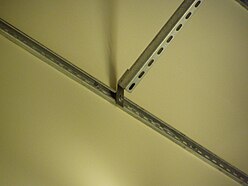
Strut channel, often referred to colloquially by one of several manufacturer trade names, is a standardized formed structural system used in the construction and electrical industries for light structural support, often for supporting wiring, plumbing, or mechanical components such as air conditioning or ventilation systems.
A strut is usually formed from a metal sheet, folded over into an open channel shape with inwards-curving lips to provide additional stiffness and as a location to mount interconnecting components. Increasingly, struts are being constructed from fiberglass, a highly corrosion-resistant material that's known for its lightweight strength and rigidity.[1] Struts usually have holes of some sort in the base, to facilitate interconnection or fastening strut to underlying building structures.
The main advantage of strut channels in construction is that there are many options available for rapidly and easily connecting lengths together and other items to the strut channel, using various specialized strut-specific fasteners and bolts. They can be assembled very rapidly with minimal tools and only moderately trained labor, which reduces costs significantly in many applications. A strut channel installation also can often be modified or added-to relatively easily if needed. The only alternative to strut channels for most applications is custom fabrication using steel bar stock and other commodity components, requiring welding or extensive drilling and bolting, which has none of the above advantages.
The basic typical strut channel forms a box measuring about 1+5⁄8 inches (41 mm) square. There are several additional sizes and combined shapes manufactured.
- ^ "Wire management". www.ecmweb.com. 30 November 1995. Retrieved 3 February 2022.